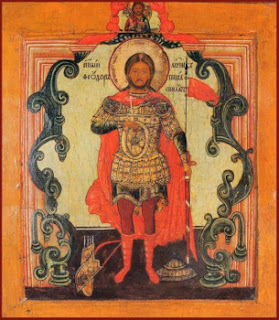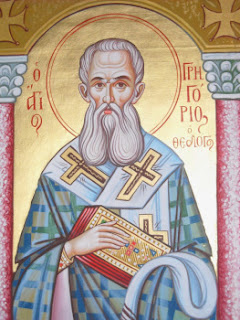The Holy Monastic Martyress Eudoxia was a Samaritan, a native of the city of Iliopolis in Phoenician Lebanon. Her pagan impiety took her off the good path, and for a long time she led a sinful life. Her soul was deadened and her heart hardened.
One time at midnight Eudoxia awoke and heard from beyond the wall in the other half of the house, where there lived a Christian, the singing of a molieben and reading of Holy Scripture, in which it spoke about the eternal bliss prepared for the righteous, and about the punishment awaiting sinners. The grace of God touched the heart of Eudoxia, and she realised that these results of her sin lay grievously upon her soul.
In the morning Eudoxia hastened to call on the man whose rule of prayer she heard by night. This was the elder named Germanos, returning from pilgrimage along the holy places to his own monastery. Eudoxia listened for a long time to the guidance of the elder, and her soul as it were came alive and she was filled with joy and love for Christ. She besought the elder Germanos to come to her after several days, during which she secluded herself within the house and gave herself over in repentance to fasting and prayer.
The elder Germanos summoned a presbyter, and after the testing of being a catechumen Eudoxia received holy Baptism from the bishop of Iliopolis, Theodotos. Having given away all her wealth to the poor, she withdrew into a monastery and took upon herself very strict acts of penitence. The Lord granted forgiveness to the penitent sinner and endowed her with graced spiritual gifts.
One time, when she was already head of the monastery, the young pagan Philostrates appeared at the monastery. Aflame with impious passion, he under the guise of a monk came into the monastery and began to urge the Nun Eudoxia to return to Iliopolis, and begin anew her former life. "May God in revenge stop thee," angrily answered Eudoxia, and the impostor-monk fell down dead. Fearing that in this she had served as an accomplice to murder, the sisters intensified their prayer and besought the Lord to reveal to them His will.
The Lord Himself appeared to Saint Eudoxia in a dream vision and said: "Rise up, Eudoxia, and get down on thy knees and pray, and thy tempter wilt arise." And through the prayer of Eudoxia, Philostrates revived. Having been restored to life, the pagan besought the nun to forgive him. And having accepted holy Baptism, he withdrew into Iliopolis. And from that time he never forgot the mercy of God shown him, and he started onto the way of repentance.
A certain while passed, when another situation occurred. Inhabitants of Iliopolis reported to the governor named Aurelian, that in accepting Christianity Eudoxia allegedly had concealed her wealth at the monastery. Aurelian sent a detachment of soldiers to confiscate these supposed treasures. But over the course of three days the soldiers tired in vain to get close to the walls of the monastery: an invisible power of God guarded it. Aurelian again sent soldiers to the monastery, this time under the lead of his own son. But on the very first day of the journey the son of Aurelian badly injured his leg and soon died. Then Philostrates counseled Aurelian to write to the Nun Eudoxia, imploring her to revive the youth. And the Lord, by His infinite mercy, and through the prayers of Saint Eudoxia, restored the youth to life. Having witnessed this great miracle, Aurelian and his close associates believed in Christ and were baptised.
When persecutions against Christians intensified, they arrested the Nun Eudoxia and brought her for torture to the governor Diogenes. The military commander Diodoros torturing her received news about the sudden death of his wife Firminia. In despair he rushed to Saint Eudoxia with a plea to pray for his departed wife. The monastic martyress, filled with great faith, turned to God with prayer and besought of Him the return of Firminia to life. Becoming convinced as eyewitnesses to the power and grace of the Lord, Diodoros and Diogenes believed in Christ and after a certain while were baptised together with their families. The Nun Eudoxia lived for awhile at the house of Diodoros and enlightened the newly illumined Christians.
One time the only son of a certain widow, working in the garden, was bitten by a snake and died. The mother bitterly bewailed her dead son. Having learned of her grief, Saint Eudoxia said to Diodoros: "The time is at hand for thee to show faith in the Almighty God, Who heareth the prayers of penitent sinners and by His mercy doth grant them forgiveness."
Diodoros was distressed, not considering himself worthy of such boldness before the Lord, but he obeyed Saint Eudoxia. He prayed and by the Name of Christ he commanded the dead one to rise, and before the eyes of everyone present the youth revived.
The Nun Eudoxia returned to her monastery, in which she pursued asceticism for 56 years.
After the death of Diogenes the new governor was Vicentius, a fierce persecutor of Christians. Having learned of the fearless confessor of the Christian faith, he gave orders to execute her. The holy nun martyress was beheaded on 1 March (c. 160-170).


























